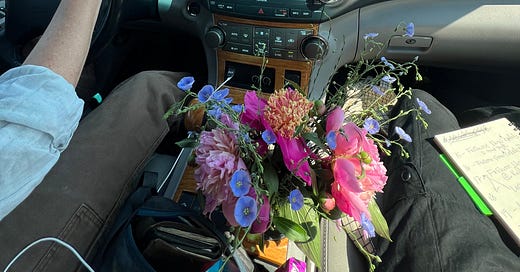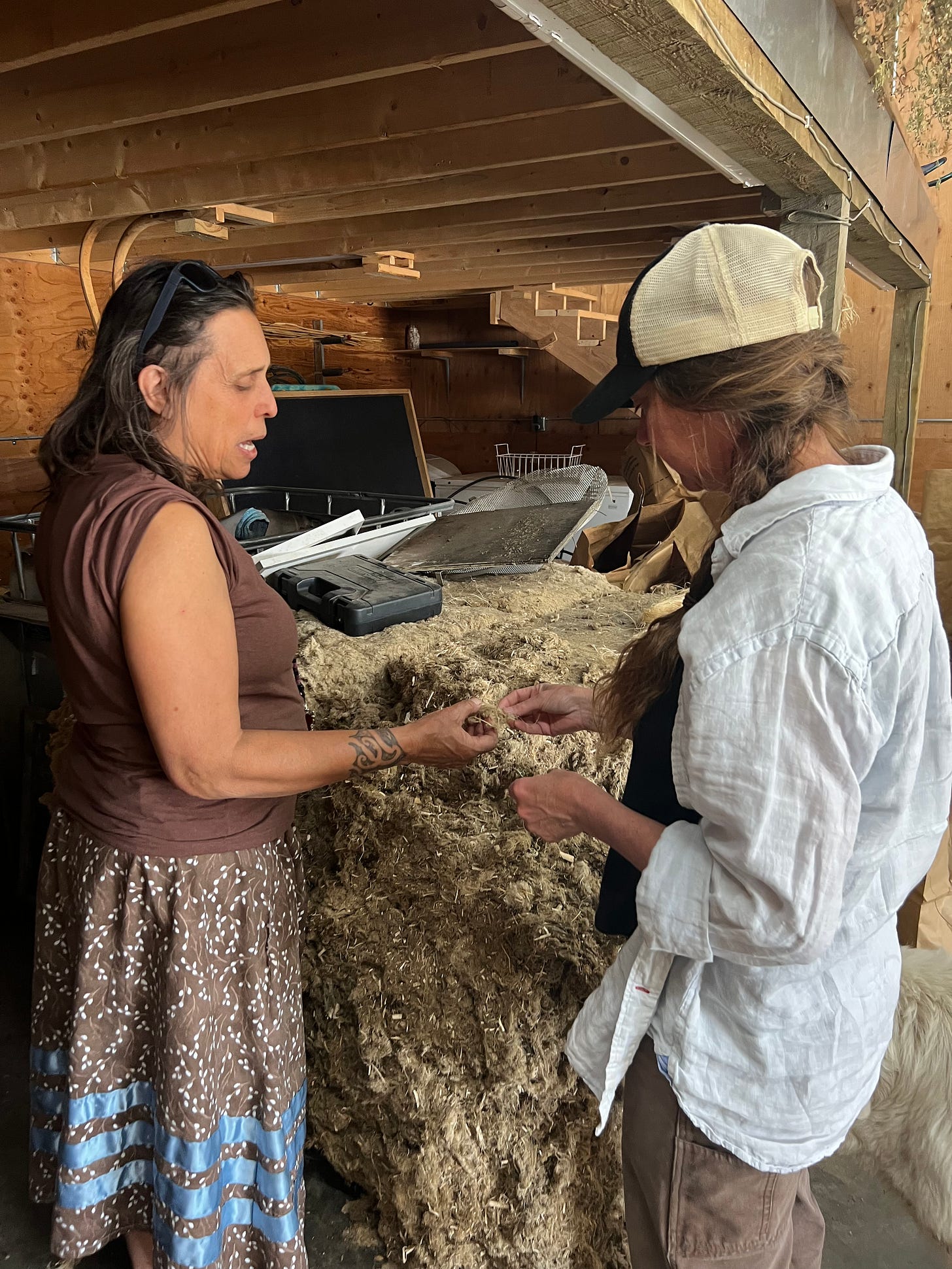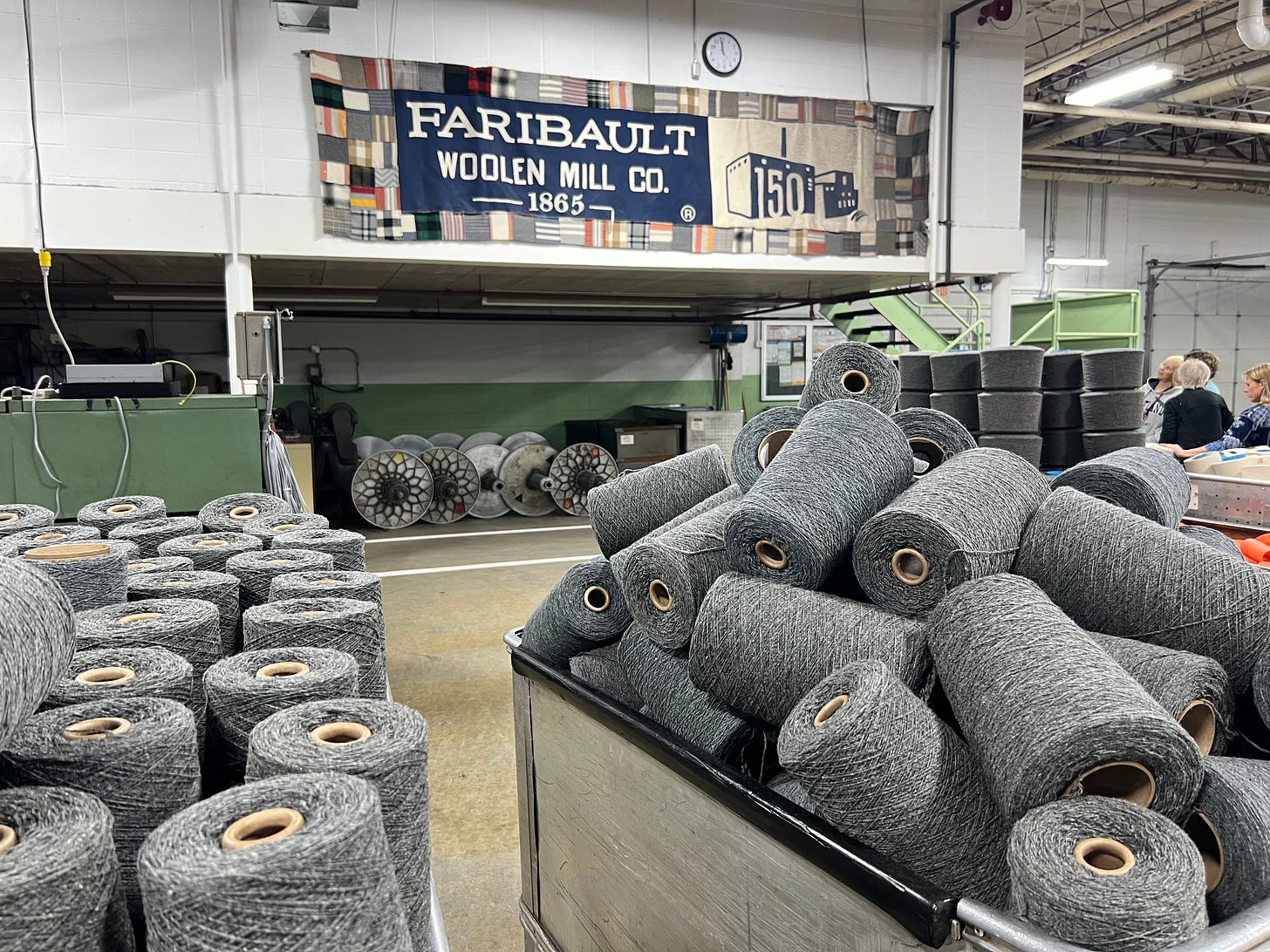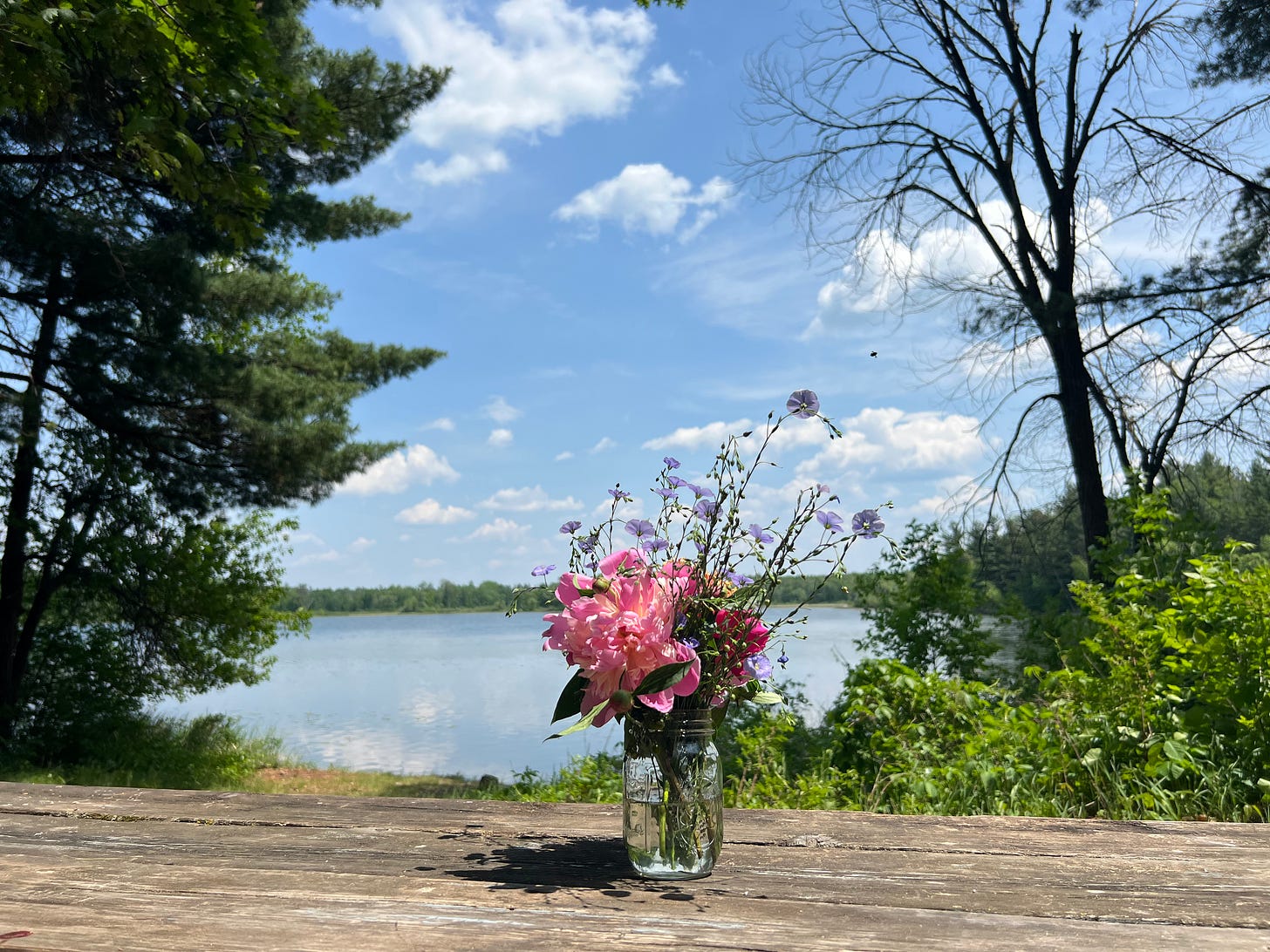Have flowers, will travel
Postcards from Minnesota: sorrow and joy, a woolen mill and hemp farms
Dear friends and readers,
I am so happy to be sitting down and writing to you.
While I marvel at the showy fuchsia roses practically glowing in my backyard, their fallen pink petals mingling with those of the orange poppies like confetti in the green grass, the chimes brought home from Indonesia knocking in the breeze, birds chattering calmly amongst themselves … people all over the country are bravely standing together against unlawful government, plutocracy, and a vengeful wanna-be dictator.
June 14th, formerly known as Flag Day.
There is a military parade in our nation’s capital.
And No Kings Day protests all over the country.
It’s another long day in the middle of June.
I sat down to write about my recent road trip to Minnesota and then learned about the assassinations in Minnesota by someone dressed up and ready to kill for that sick MAGA cult. What a tragedy. The brainwashing, the killing, the sorrow and pain.
And still the birds keep going about their important business. Heavy black crows drop down into the cherry tree to feast, dominating the scene with their loud voices. A small brown songbird is watching me from the elderberry bush. Brown-birdie brethren are obscured within the dense foliage of the bush. My large tabby cat just sat down next to me to observe the scene, too. He’s mostly harmless.
These details of life are complex and simple.
I know that joy is not separate from sorrow. The interwoven threads of sorrow and joy are the commonality we share. As my yoga teacher on Friday wisely reminded a room full of warriors, we can hold multiple threads. Both and. Sorrow and joy are how it feels to be human.
Nearly all of my spare moments lately have been preoccupied with all things flax and linen — which has been wonderful. The series of events I’ve mentioned before called Field to Frock is coming right up (June 20-22 in Madison, WI). I’ve happily taken up the job as volunteer outreach and communications specialist for the change-making organization called Midwest Linen Revival, and this purposeful, visionary work has brought me a lot of joy during challenging times.
So I sat down to tell you about the roadtrip I took to Minnesota to explore the midwestern fibershed and expand my understanding of textile production. With my co-pilot, the founder of Midwest Linen Revival, we visited one of only two vertical woolen mills left in America. At Faribault Mill, “fifth-generation craftspeople” produce gorgeous woolen blankets and clothes using hulking, irreplaceable old machinery paired with modern technology. We also visited the White Earth Reservation, where Akiing’s New Green Revolution program is farming hemp under Winona LaDuke’s leadership as a way of restoring land, economies, and the Anishinaabe way of life in the Great Lakes region.
We covered more than 1,000 miles with a bouquet of peonies and flax flowers in the cup holder of the car, filling the airspace with the scent of beauty. Complex and simple.
“What if joy is not only entangled with pain and sorrow and suffering but is also what emerges from how we care for each other through these things?”
-Ross Gay, from Inciting Joy
Postcards from Minnesota
AKI ING Community Organization and Hemp Farms
We pulled into the gravel drive of Aki ing farm and parked between the chicken coop and pole barn. There were a handful of other vehicles but the scene was pretty quiet. A grey horse walked through the gravel lot, free-range style, while we tried to get the lay of the land. A middle-aged man appeared out of nowhere to tell us to go on inside. “Just walk in,” he said, “that’s what everyone does.” He was a machinist from the Pine Ridge Reservation who had arrived a few days earlier to help out.
“We’re making you a rhubarb cake,” Winona LaDuke said in greeting. A young intern and the 65-year-old activist were fiddling with the oven, which wasn’t working. After a little chit-chat, Winona led us back outside to the pole building, saying “The Russians are in here.” We thought she meant the two WWOOF volunteers who had pulled up unannounced that morning from their #vanlife adventures, but she was talking about her hemp seeds.
I learned that Aki ing and the New Green Revolution project is working to develop a strain of hemp for fiber using seeds from plants that have been growing wild on the reservation. The idea is to take advantage of those stubborn and thriving qualities of plants still growing from lineages once cultivated and tended by the Indigenous people of the Great Lakes. But for now, the seeds they farm come from China and Russia.
An intern, or maybe it was an artist, was invited to paint a mural of ‘The Story of Hemp’ on a wall, connecting that lineage to the long history of hemp and humans. During the pandemic, LaDuke told us, she’d also had the word ESSENTIAL painted in the work barn.
By the end of the day, we were doing dishes in the kitchen and could have stayed for pesto pasta but instead went back to our campsite to enjoy the sunset. On our way south the next day, we stopped at the Giiwedinong Treaty Rights and Culture Museum, which is in the former Enbridge Energy Company offices in Park Rapids, Minnesota. A bag made by Patagonia from Aki ing hemp was purchased from the gift shop, then we carried on.
LEARN MORE ABOUT THE BAG MADE FROM HEMP HERE
Faribault: An American Woolen Mill
The morning tour of the woolen mill was sold out, but the woman on the phone said to come early and she’d show us around. When we arrived, we started talking about the mill’s 160+ year history and were conspiratorially told that we could slip into the tour for free. But first, before the tour started, we popped across the river to the historical society museum, where we learned that Faribault, Minnesota was named for the Faribault family, who had close relations with local Dakota communities. The US-Dakota war of 1862 “remains one of the most important events in Minnesota history,” according the historical society.
I’ve never been inside a fabric mill before. This was a pretty neat experience — to see huge bales of raw wool, the industrial machines for carding the wool, and the mechanized stages of getting that wool dyed and spun into yarn, then woven, washed, cut, and sewn. A blanket takes ten days to make and there are nearly 100 employees working 10-hour days. When the military contract blankets are on deadline, the tour guide explained that “everyone becomes a professional blanket folder.”
CHECK OUT THE SPECIAL COLLECTION BY ARTIST DYANI WHITE HAWK
Thank you for joining me on the wandering journey.
👉 If you got this far, please click the ❤️!
Take care of yourself and carry on caring for each other.
“A New National Anthem”
The truth is, I’ve never cared for the National
Anthem. If you think about it, it’s not a good
song. Too high for most of us with “the rockets’
red glare” and then there are the bombs.
(Always, always there is war and bombs.)
Once, I sang it at homecoming and threw
even the tenacious high school band off key.
But the song didn’t mean anything, just a call
to the field, something to get through before
the pummeling of youth. And what of the stanzas
we never sing, the third that mentions “no refuge
could save the hireling and the slave”? Perhaps
the truth is every song of this country
has an unsung third stanza, something brutal
snaking underneath us as we absentmindly sing
the high notes with a beer sloshing in the stands
hoping our team wins. Don’t get me wrong, I do
like the flag, how it undulates in the wind
like water, elemental, and best when it’s humbled,
brought to its knees, clung to by someone who
has lost everything, when it’s not a weapon,
when it flickers, when it folds up so perfectly
you can keep it until it’s needed, until you can
love it again, until the song in your mouth feels
like sustenance, a song where the notes are sung
by even the ageless woods, the shortgrass plains,
the Red River Gorge, the fistful of land left
unpoisoned, the song that’s our birthright,
that’s sung in silence when it’s too hard to go on,
that sounds like someone’s rough fingers weaving
into another’s, that sounds like a match being lit
in an endless cave, the song that says my bones
are your bones, and your bones are my bones,
and isn’t that enough?-Ada Limón
Sincerely,
Jessica














Love the flowers and the article. I wish I could join you.
love the photos!